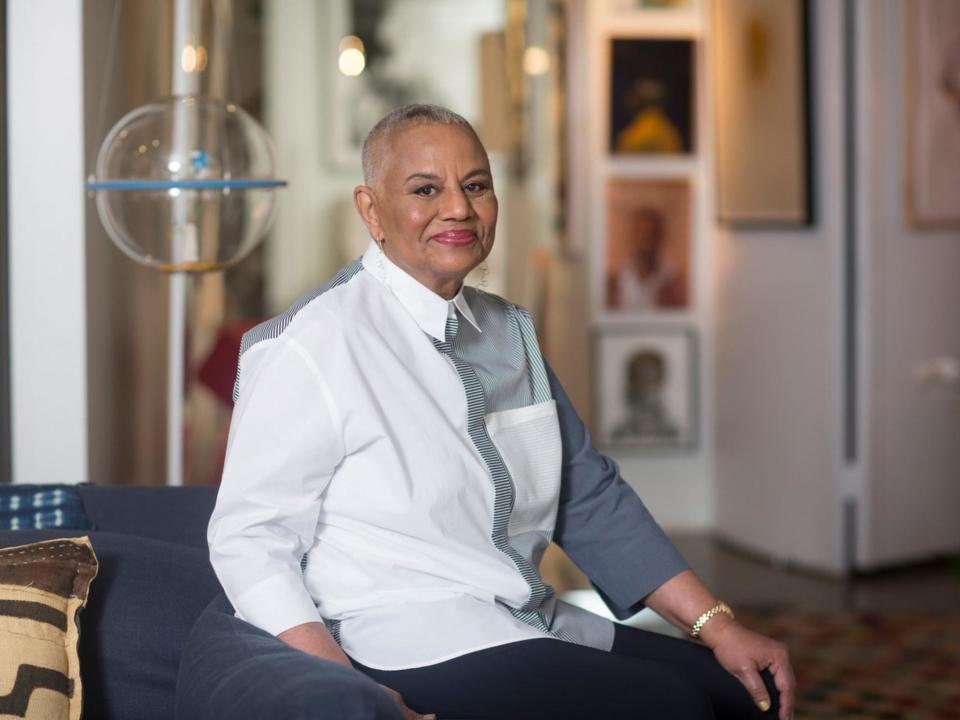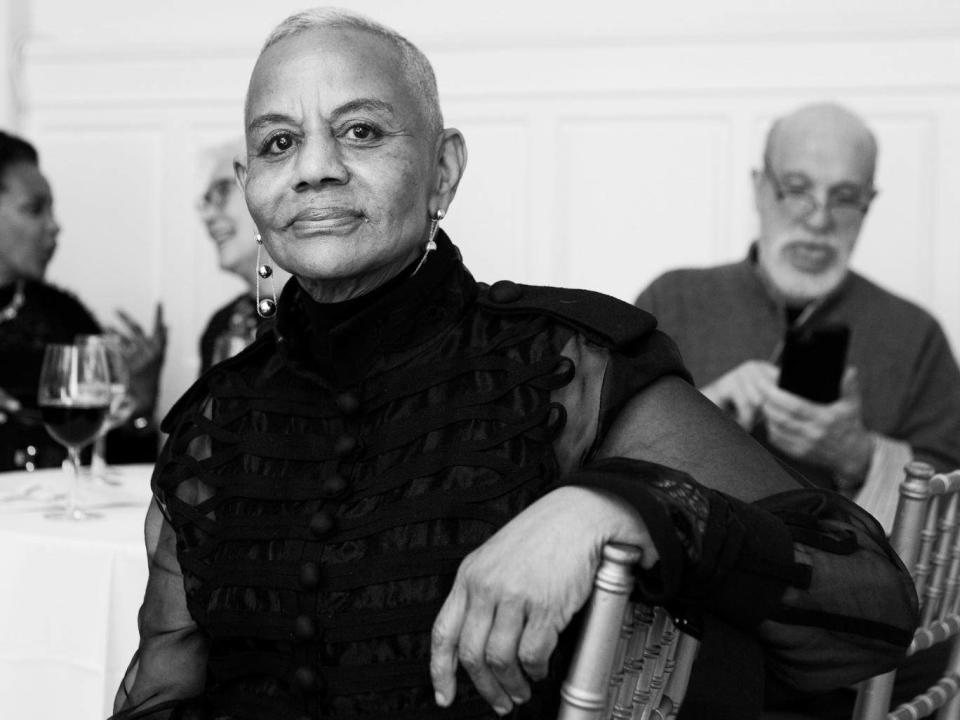Peggy Cooper Cafritz: Outspoken champion of social justice, the arts and education in Washington DC

Peggy Cooper Cafritz, one of America’s best known advocates for the arts and education, tried to mend many of the Washington DC areas social and racial wounds.
Cooper Cafritz, who has died aged 70, created one of the US’s leading arts-intensive high schools, and capped her community involvement with what turned out to be a divisive six-year tenure as president of Washington DC’s Board of Education.
Cooper Cafritz came from a prosperous African-American business family in Mobile, Alabama but the family’s standing in the community did not insulate them from bitter indignities of the Jim Crow South. Galvanised by the burgeoning civil rights movement, Cooper Cafritz left her home to study at George Washington University in 1964.
She was determined to end the vestiges of racial segregation on campus.
Once settled in, she organised a black student union and helped force many fraternities and sororities to adopt “race-blind” charters. She also co-created a pilot workshop in creative arts in the summer of 1968 which planted the seed for the Duke Ellington School of the Arts.
The school, modelled on New York City’s High School of Performing Arts, was a breakthrough for DC students gifted in dance, painting, music and theatre but ill-suited to traditional schools. Duke Ellington opened in 1974 and boasts graduates including comedian Dave Chappelle and the mezzo-soprano Denyce Graves.
Over five decades, Cooper Cafritz became a fixture of Washington’s educational, cultural and charitable firmament. Part socialite, part social activist, she married into – and bitterly divorced out of – the Cafritz property and philanthropic fortune. Her social orbit included Bill Clinton, Gloria Steinem, Quincy Jones, Vernon Jordan and Alma Powell, the wife of Colin Powell.
She amassed one of the largest private collections of both African-American and African art, much of which was destroyed in 2009 by a fire at her hilltop mansion. Her estate became a salon where, with formal charm and brusque efficiency, she linked the policymakers, cultural leaders and real estate developers of both official and unofficial Washington sets.
Cooper Cafritz was a constant presence on the political fundraising circuit, and as an arts reviewer on Around Town, a programme on a local public television station. She also was chairman emeritus of the DC Commission on the Arts and Humanities and a board member of arts institutions such as the John F Kennedy Centre for Performing Arts.

She said her overarching mission was “to bridge the great divides” among the city’s factions in arts and politics. “The majority of power in this city is black, and the majority of money is white,” she said as back in 1979. “We’ve got to bring the two together. At some point in this society, everything has to converge.”
Cooper Caftiz took a personal step in that direction two years later, when she married her longtime companion, Conrad Cafritz, a scion of one of Washington’s wealthiest families. “I met him on the telephone,” she once recalled. “He called me to ask me for a reference for somebody.” It was then that she cursed. He said, “That’s an interesting response. Can we meet?”
During their long courtship, they cut a striking profile as one of the few mixed-race couples in the city’s elite – Mr Cafritz was white. But the marriage rapidly grew troubled. Her lawyers claimed in divorce proceedings in the late 1990s that Conrad Cafritz “referred to their relationship as a ‘European style’ marriage, with each being free to have sexual relations with others as they desire, despite Mrs Cafritz’s wishes to the contrary.” In his court filings, Conrad Cafritz disputed many of the allegations.
After reaching a settlement, Cooper Cafritz retained the home, with its tennis and basketball courts and pool, as well as a secretary, cook, housekeeper and driver. Citing a source familiar with her finances, The Washington Post wrote in in 2002 that she received about $600,000 annually in child support, alimony and investment income.
In the wake of her divorce, Cooper Cafritz devoted her energies to pursuing elective office. In 2000, she vied successfully for the DC school board presidency, positioning herself as a revolutionary underdog. She was elected just as the federally appointed DC financial control board was returning control of the troubled education system to the school board.
The school board was long a battleground, but many education officials claimed it became less effective and more polarised during Cooper Cafritz’s time as president.
With a penchant for closed-door decision-making, she was perceived as aloof and authoritarian. She was unfiltered in her public remarks, slamming unqualified and incompetent teachers plaguing the school system.
She also drew a link between feckless parenting and children with special needs. “The reason we have so many special education students,” she once said, “is you have children who have no father, and they go home to a mother who’s on the couch eating potato chips and she pays no attention to the child, and he comes back to school and he wants attention, so he acts out.”
Cooper Cafrtiz provoked bewilderment by taking strong positions both for and against school vouchers (these enable parents to use public money to send their children to private in America; or parochial schools – those affiliated to a religious organisation). Once, she claimed that a hacker had penned an anti-voucher essay that appeared under her name, on her own website, before admitting that she had, in fact, helped to write it.
To supporters, she was a dogged champion of accountability in an unwieldy bureaucracy that no one person could fix. To her detractors, she was a bully.
She and members of Washington’s City Council sniped at each other in meetings over matters petty and large, and she gradually lost the backing of the then Mayor Anthony Williams. By the time she declined to run for re-election, she was credited with doing little to advance the 55,000-strong student system, although she reached for her own money to replenish school library shelves.
As her tenure drew to an end, she personally took out a $40,000, full-page advertisement in The Washington Post that trumpeted her service, noting an uptick in the number of students going to college.
“There are a lot of people who I can make scream when they hear my name,” she said in 2006. “I think a lot of people can’t stand the fact that I’m a rich lady on the hill. They think I couldn’t possibly give a damn about the kids. They also don’t appreciate the fact that I say what I think.”
Longtime political commentator Mark Plotkin called Cooper Cafritz “a controversial, provocative figure” in a city that does not embrace bureaucratic mavericks.
“She had many detractors,” he said, “but what cannot be taken away from her is the singular achievement of the Duke Ellington School of the Arts. She was not a consensus builder or namby-pamby if she wanted to accomplish something.”
Pearl Alice Cooper, who later officially changed her name to Peggy, was born in Mobile, Alabama.
Her parents owned a mortuary and life insurance business. When one of her older brothers was denied a place in an all-white Catholic high school, her parents decreed that their six children would be educated out-of-state at private schools. The financial strain eventually resulted in her father killing himself, the family told reporters.
“My father often said to me that he wanted me to be as comfortable sitting in a melon patch as I would be in an audience with the Queen,” Cooper Cafritz once said, “as comfortable reading Aquinas as I would be reading WEB Du Bois. You are supposed to be wherever you are, he said. I never felt any fear about where I belonged.”
After graduating in 1964 from St Mary’s, a predominantly white Catholic boarding school in South Bend, Indiana, Cooper Cafritz returned home and, along with friends, organised an effort to test the newly passed civil rights law outlawing racial discrimination in public facilities. She recalled being spat on by white youths at a drive-in.
That fall, she entered George Washington University as one of the few blacks on campus, drawing media attention with her efforts to challenge de facto segregation. When it came to sororities, that she “didn’t measure up Hellenistically” – as The Post wryly expressed it at the time, came as no shock to her. As a founder of the Black Students Union, she pushed the student government and administration to demand that so-called Greek-letter organisations on campus prohibit discrimination or close. The measure passed in 1968.
Although she graduated that year and then received her law degree in 1971, she said she had no intention of practising law. The “Esq” after her name, she said, would “increase my credibility and open a lot of doors.”
The origins of Duke Ellington reached back to 1968, when she staged an arts festival and arranged for inner-city youths to be bussed to campus to see exhibitions of black dance, art, music, literature and clothing. Meeting teenagers who were “talented but very raw” impelled her and a friend – director and choreographer Mike Malone – to create a summer arts workshop for high-schoolers. Cooper Cafritz saw creative promise in the most troubled of the lot.
“Why does a kid get kicked out of school?” she said rhetorically. “Because he’s in trouble. And if you think about it, he’s had to design the architecture of the trouble. Wow – he must really have something on the ball.”
Over the next several years, she almost single-handedly collected millions of dollars to help the program evolve into the Duke Ellington School, housed at the site of the former Western High School in Georgetown. She spoke of the Ellington school as a vital social juncture, commingling students of all ethnicities and economic backgrounds, bound by a common devotion to the arts. The school, now highly competitive, underwent a major renovation that was completed last year with $100m in overspend.
In the 1970s, with her rising profile in the community, Cooper Cafritz became the youngest fellow of the Woodrow Wilson International Centre for Scholars and served on a committee that created the University of the District of Columbia from two other academic institutions.
She was a programming executive and documentary producer for WTOP-TV in Washington and an assistant to the president of Post-Newsweek Stations Inc. She also worked briefly with Harry Belafonte and M Carl Holman, president of the National Urban Coalition, in an unsuccessful attempt to launch a “minority cultural project” for public television.
In addition to raising three children, Cooper Cafritz became guardian and godmother to dozens of youngsters over the decades, often paying for their educations.
She is survived by three children, Arcelie Reyes, Zach Cafritz and Cooper Cafritz, both of Washington.
Artist Nekisha Durrett once described Cooper Cafritz’s home as the “Hermitage of African-American art,” referring to the world-renowned museum in St Petersburg. The owner was staying with friends in Martha’s Vineyard, Massachusetts, when a fire one night in July 2009 rapidly engulfed the property and destroyed more than 300 pieces of art, including works by Jacob Lawrence and Romare Bearden.
City and federal investigators ruled the blaze accidental, attributing it to linseed-oil-soaked paper towels left in a plastic trash bag on her porch. Firefighters said inadequate water pressure from nearby hydrants stymied their efforts to control the conflagration.
Cooper Cafritz spent years suing the city’s water authority, citing what she alleged was its failure to maintain neighbourhood fire hydrants, and settled for an undisclosed amount in 2014.
In 2011, she moved into a $3.25m, 5,400ft Dupont Circle condominium that she had completely rebuilt to showcase what remained of the art trove that she set about rebuilding.
Peggy Cooper Cafritz, patron of the arts and education, born 7 April 1947, died 18 February 2018
© Washington Post

 Yahoo News
Yahoo News 